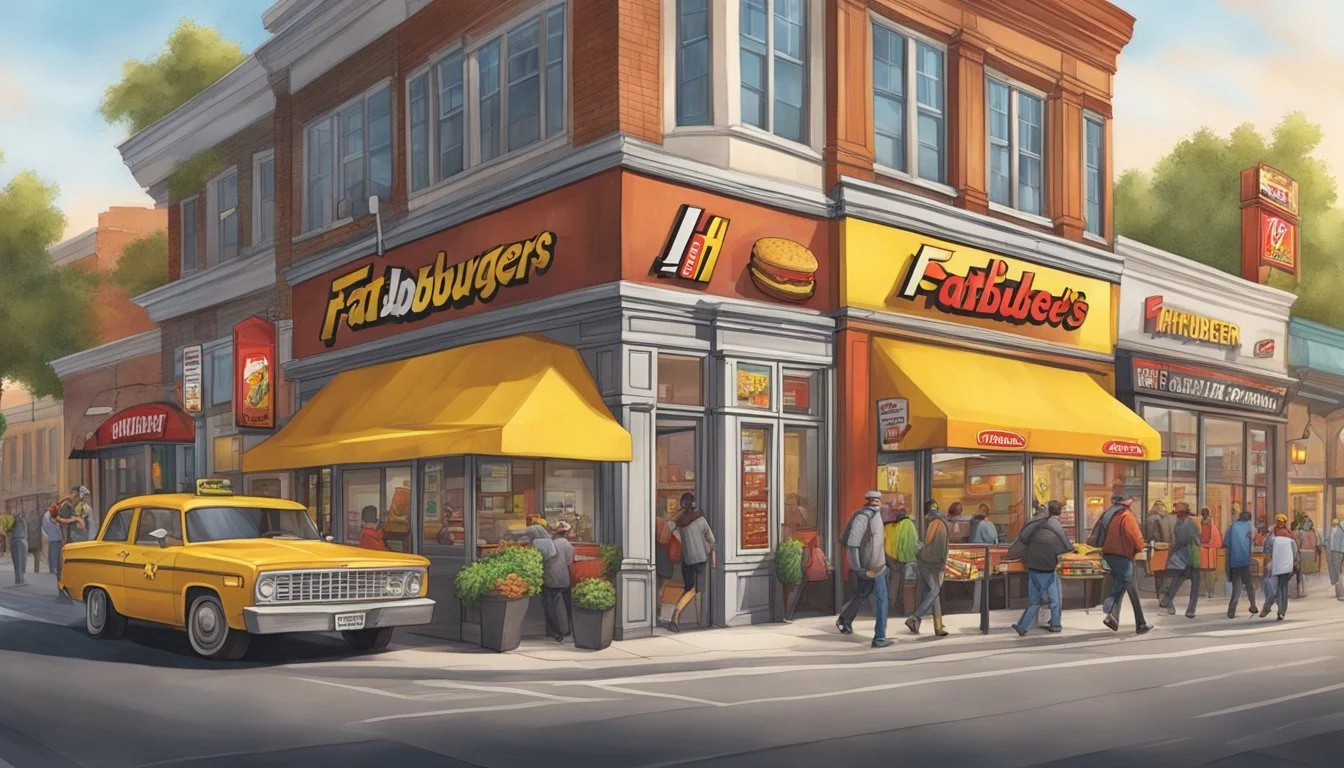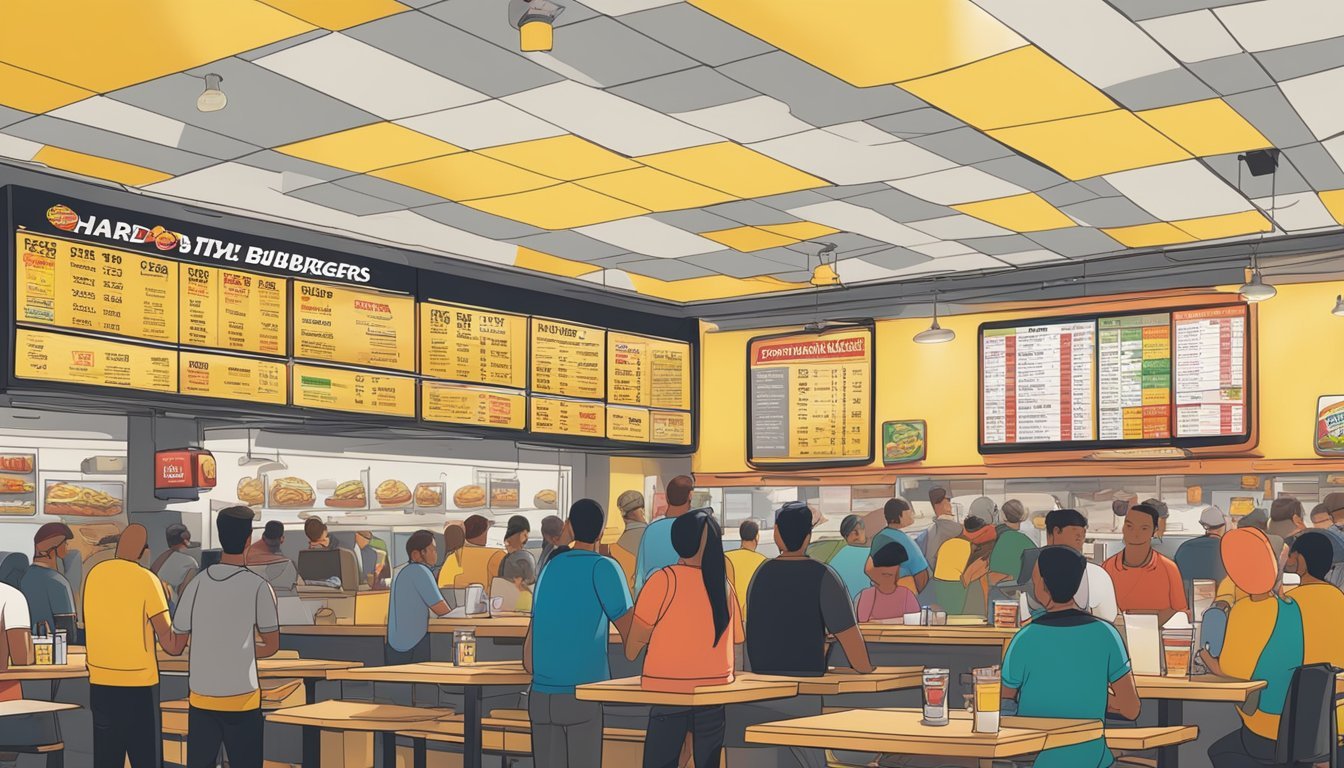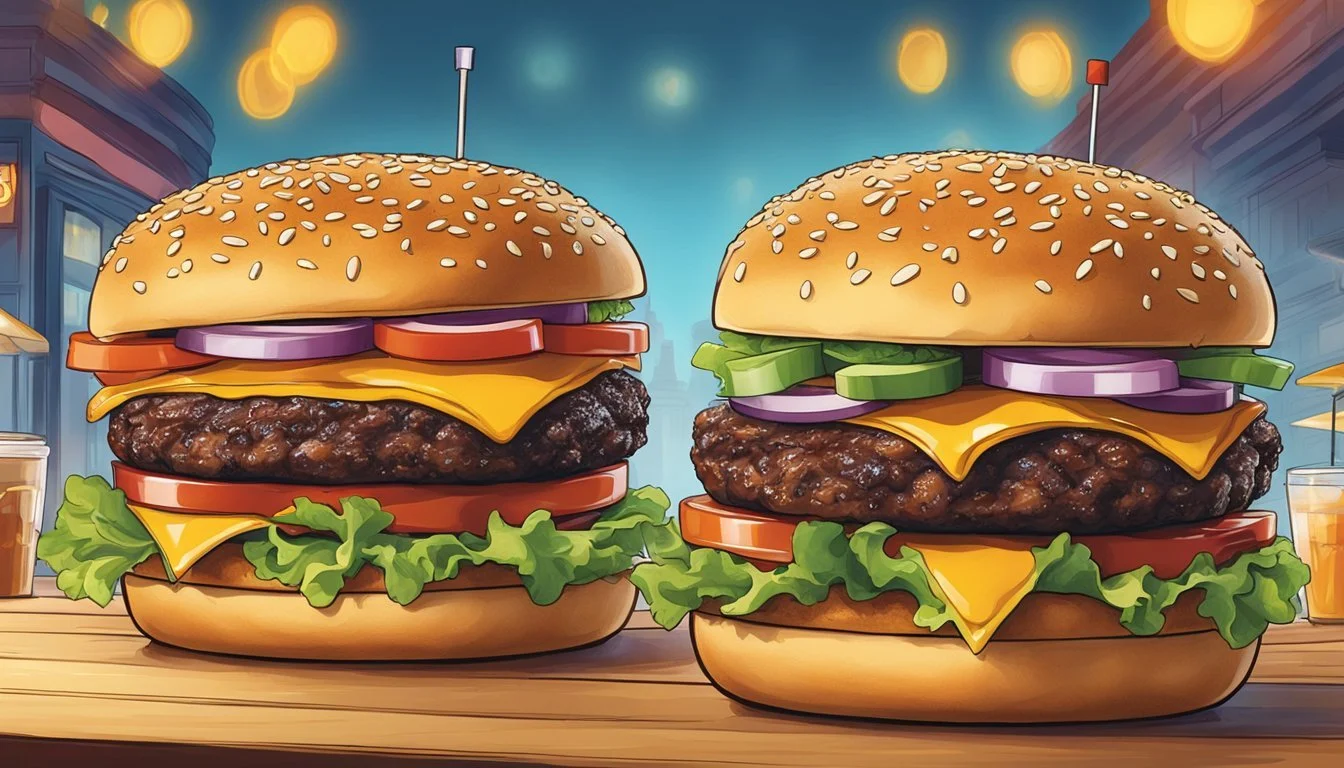Fatburger vs Hardee's
An In-depth Comparison of Burger Giants
When assessing the merits of Fatburger versus Hardee's, it's about more than just choosing a place to eat; it's about selecting an experience. Both burger joints have carved out their niches in the fast-food industry with distinct approaches to the classic American hamburger. Fatburger, founded in 1947, offers a menu celebrated for its customizability and classic California-style burgers. Hardee's, on the other hand, established in 1960, has built a reputation with its Thickburgers and a focus on bold flavors and hearty portions.
To determine which chain comes out on top, one must consider a variety of factors including the quality of ingredients, the range of options available, and the overall dining experience. While Fatburger has a steadfast commitment to offering fresh, made-to-order burgers, Hardee's competes with a menu that also includes a variety of other items such as breakfast foods and chicken tenders. Both chains provide a selection of toppings and customization options, allowing diners to tailor their meal to their exact preferences.
The preference between Fatburger and Hardee's ultimately depends on the individual consumer's tastes and priorities. Some may favor Fatburger's fresh, never-frozen beef and extensive topping choices, which include items like chili, egg, and onion rings. Others might lean towards Hardee's for its thick, charbroiled burgers and signature sandwiches that deliver rich, indulgent flavors. Whether one values a more bespoke burger-making process or a bold, no-nonsense approach to fast food, both Fatburger and Hardee's stand out in the fast-food arena.
Historical Overview
Fatburger originated in California in 1952, founded by Lovie Yancey. It started as a small hamburger stand known as "Mr. Fatburger," before the "Mr." was dropped. Over the years, Fatburger has maintained a commitment to large, fresh, custom-made burgers, becoming a well-known establishment along the West Coast. Fatburger places emphasis on quality, using lean beef for their well-known "Fatburger."
Hardee's, on the other hand, was founded in 1960 by Wilber Hardee in Greenville, North Carolina. Hardee's quickly found its footing in the American fast-food scene, differentiating itself by its biscuits and an emphasis on slightly larger, more premium burger offerings compared to other national chains. Having merged with Carl's Jr. in 1997, the Hardee's brand expanded its reach across America, though maintaining distinct menu items in accordance with regional preferences.
Both establishments have become ingrained in America's cultural landscape, contributing to the nation's fast-food identity:
Fatburger: Recognized for its customizability.
Hardee's: Known for its premium Thickburgers and hand-scooped ice cream shakes.
With both being national chains, Fatburger and Hardee's have contributed to America's love for burgers, adapting and growing through the decades to cater to evolving consumer tastes and preferences. Each chain has developed its own loyal customer base and boasts a significant presence across the country, serving generations of Americans with their unique burger experiences.
The Burger Heavyweights
Fatburger and Hardee's are well-regarded in the fast-food world, each bringing a distinctive approach to crafting the classic American burger.
Fatburger is known for its fresh, custom-made burgers. Emphasizing quality, the chain offers a range of sizes from small to XXXL, catering to all appetites. Their signature burger, the Fatburger, consists of lean beef with traditional toppings like lettuce, tomato, onion, pickles, mayonnaise, and mustard, all enclosed in a toasted bun.
Hardee's, on the other hand, leans towards bold flavors and hearty options. One standout is the Frisco Burger which combines a 100% beef patty with bacon, mayonnaise, tomato, and Swiss cheese on buttered sourdough toast — a combination playing to American comfort food cravings.
Aspect Fatburger Hardee's Patty 100% Lean beef 100% Beef Toppings Customizable, fresh variety Bacon, cheese are staples Bread Toasted bun Sourdough toast, buns Experience Fast-casual Fast-food
While both establishments offer quality burgers, the choice ultimately comes down to preference — the customizable, lean-beef option from Fatburger or the indulgent, flavor-packed choices from Hardee's. Their dedication to the craft of burger-making secures their spots as heavyweight contenders in the fast-food burger scene.
Menu Diversity and Options
When comparing the menus of Fatburger and Hardee's, it's essential to consider the variety and uniqueness of what's offered. Each chain brings its own flavor to the table with a range of burgers, toppings, and additional menu items.
Burger Varieties
Fatburger stands out with its signature offering, the Fatburger, which comes with options for beef patty size ranging from small to XXXL. Hardee's, on the other hand, offers a variety of options like the Thickburger lineup including options like the Original Thickburger, Bacon Cheeseburger, and Monster Thickburger.
Signature Toppings and Condiments
Hardee's toppings include the classic lettuce, tomato, onions, pickles, ketchup, and a range of mayo options, while its condiments are more traditional, like ketchup, mustard, and mayonnaise. Fatburger provides a diverse selection of free toppings which include traditional offerings as well as grilled mushrooms, jalapenos, and green peppers; they also provide an array of sauce options like BBQ, hot sauce, and A.1. sauce.
Beyond Burgers: Additional Offerings
Both chains offer more than just burgers. Hardee's menu includes other sandwich options like chicken sandwiches and wraps. For sides, they have fries and occasionally specialty items like the Frisco Burger. Fatburger also serves up alternatives such as sandwiches, and they feature an Impossible Burger, catering to those wanting a plant-based option.
Unique Menu Items
Hardee's has menu items like the Frisco Burger that feature sourdough bread, while Fatburger hops on the uniqueness train with its own Fatburger that is served with lean beef. Neither chain shies away from offering distinct flavors and specialties that elevate their menus beyond the standard burger fare.
Nutritional Profiles
When comparing Fatburger and Hardee's, one noticeable difference lies in their nutritional offerings, which may influence a diner's choice based on health or dietary considerations.
Caloric Content and Health Considerations
Fatburger's menu highlights various sizes of their namesake burgers, with the "Baby Fat" Fatburger containing approximately 400 calories, while their "Original" Fatburger has 590 calories, and the "Kingburger" Fatburger tops the scale at 850 calories. Each burger's caloric content rises with the addition of cheese, bacon, or extra toppings.
Hardee's, on the other hand, features the Thickburger line, with calories ranging notably depending on the selection. The 1/3 lb Original Thickburger, for instance, has over 700 calories. Both eateries offer options that can fit into a more calorie-conscious diet, but vigilance is key when navigating their menus for healthier choices.
Freshness and Quality of Ingredients
Both Fatburger and Hardee's assert the use of fresh ingredients in their burgers. Fatburger takes pride in using lean beef for their patties and offers fresh toppings such as lettuce, tomato, and mushrooms. Hardee's also commits to using 100% beef in their Thickburgers and often incorporates freshly sliced tomatoes and lettuce. The quality of ingredients can directly influence the nutrient density of each burger, although the exact sourcing and handling of these ingredients are proprietary to each chain.
Special Dietary Options
Catering to diverse dietary needs is where both brands have adapted over time. Fatburger provides options for those seeking lower calorie or smaller portion sizes with their "Baby Fat" burgers and highlights the ability to customize toppings according to one's dietary preferences. Hardee's offers a range of burgers that can be adapted to lower-carb diets by forgoing the bun, although their menu may be limited for those looking for vegetarian or vegan options.
In recent years, both chains have made efforts to include more special dietary options. Fatburger boasts a Veggieburger for vegetarian customers and has a gluten-free bun option. Hardee's, while not as expansive in vegetarian offerings, has taken steps to incorporate low-carb alternatives and has options for those avoiding gluten to customize their orders accordingly.
Brand Presence and Customer Loyalty
When exploring the competitive landscape of Fatburger versus Hardee's, it's essential to consider their national and regional footprint, marketing initiatives, and customer satisfaction—all of which play pivotal roles in shaping brand presence and nurturing customer loyalty within the fast-food industry.
National and Regional Footprint
Fatburger has established itself as a strong fast-food contender, primarily in the American West and with international locations, catering to burger enthusiasts through its retro diner experience. In contrast, Hardee's, part of the CKE Restaurants Holdings that also includes Carl's Jr., casts a wider net across the United States, particularly in the Midwest and Southeast regions, ensuring its presence where traditional burger joints like Five Guys and Whataburger also compete.
Marketing Initiatives and Branding
Hardee's leverages bold and often provocative campaigns to differentiate its brand in a crowded market, which includes competitors such as McDonald's and Burger King. To maintain its relevancy and appeal to a younger demographic, Hardee's frequently updates its branding and menu offerings. Meanwhile, Fatburger focuses on a nostalgic feel that honors its Los Angeles origins, along with a focus on fresh, custom-made burgers, helping it to maintain a unique position, much like In-N-Out, within the fast-food burger landscape.
Customer Service and Satisfaction
Both brands have their loyal followings, with customer service often being a linchpin for repeat business. Hardee's, along with other chains like Sonic Drive-In and Steak 'n Shake, is known for their quick service and varied menu. Fatburger, on the other hand, boasts a strong fan base built on its commitment to large, customizable burgers. This dedication to customer preference is also seen in chains like Smashburger and Fuddruckers. Customer service triumphs, paired with positive dining experiences, fortify the customer loyalty requisite for the lasting success of any fast-food entity.
Price Point and Value for Money
When considering Fatburger and Hardee's, customers often weigh the overall value for the amount spent. This encompasses direct pricing, meal deals available, and ongoing promotions.
Cost Comparison
Fatburger:
Base burger price: Starts around $5.99 for the Original Fatburger.
Combo meal price: Approximates $8.99, including fries and a drink.
Hardee's:
Base burger price: The Famous Star starts at $4.49.
Combo meal price: Typically $7.49 for a burger, fries, and a drink.
Fatburger's offerings are slightly higher priced, but they also promote larger, heftier burgers, which may justify the cost for those seeking a more substantial meal. Hardee's, conversely, caters to a more budget-conscious diner with their pricing strategy, presenting itself as a more economical choice.
Meal Deals and Promotions
Fatburger:
Meal Deals: Periodically offers deals such as "meal for two" at indicative prices such as $11.99, subject to location and availability.
Coupons: They circulate various discounts and coupons, primarily through their e-club memberships and apps.
Hardee's:
Meal Deals: Frequently has "buy-one-get-one" offers on their burgers and "meal bundle" discounts, particularly during promotional periods.
Discounts: Regularly promotes the use of coupons available through circulars and digital apps, which offer significant price reductions.
Both Fatburger and Hardee's give patrons options for added value through meal deals and promotions. Fatburger's deals tend to center around bulk or shared offerings, whereas Hardee's often has more individual-focused promotions, offering a lower entry price point with their discounts and coupons.
Consumer Experience
When choosing between Fatburger and Hardee's, consumers weigh distinct aspects of their dining experience. These include the ambiance of the locations, the speed and efficiency of service, how each brand adapts to new trends, and the advantages offered by their rewards programs.
Dining Ambiance
Fatburger tends to provide a classic diner atmosphere, often featuring jukeboxes and a retro feel that harks back to the 1950s. The open kitchen concept allows diners to witness their food being freshly prepared, which enhances the overall experience. In contrast, Hardee's leans more towards a modern fast-food setting with a focus on convenience for drive-thru and drive-in customers. Both establishments maintain clean and well-organized spaces, although Fatburger's extra touches foster a more inviting sit-down experience.
Service Speed and Efficiency
In the realm of service, Hardee’s often edges out with their efficient drive-thru experience, a nod to the fast-paced demands of today’s fast-food trends. Fatburger, while not as widely recognized for speed given its cook-to-order approach, still maintains a reasonable turnaround on orders. Both burger joints have streamlined ordering systems, yet Hardee's might appeal more to those in a hurry.
Innovation and Adaptability
Embracing fast-food trends, Hardee’s has introduced options such as the Impossible Whopper to cater to a growing demand for plant-based alternatives, indicating adaptability and a forward-thinking approach. Fatburger is also not shy about innovation, having added vegan options like the Impossible Burger to its menu. Both brands show an eagerness to adapt to the evolving tastes and dietary preferences of their patrons.
Loyalty Programs and Rewards
Hardee's offers a range of deals and rewards through its loyalty program, appealing to regular customers looking to save. Fatburger, while not as prominent in this area, has engaged diners with occasional promotions and discounts. Savvy consumers often leverage these programs to get the most out of their dining dollars, with each brand providing unique incentives to keep their customer base returning.
Final Verdict
In pinpointing the superiority between Fatburger and Hardee's, this section focuses on firsthand taste accounts, critical assessments, and consumer sentiment to deliver a decisive judgment.
Taste Testimonials
Fatburger testimonials often highlight the savory taste of their classic Fatburger, noting the lean beef’s contribution to a favorable texture and flavor profile. Hardee's, on the other hand, is known for its Thickburger, with fans frequently emphasizing the burger’s juiciness and satisfying bite.
Fatburger: Lean beef, a variety of toppings, and fresh ingredients.
Hardee's: Thick and juicy beef patties, often accompanied by options like cheese and bacon.
Expert Opinions and Rankings
In expert rankings, Fatburger is typically commended for offering a customizable burger experience, with a range of free toppings enhancing the overall eating encounter. Conversely, Hardee's is often acknowledged for its consistent quality across its menu items, with the bacon cheeseburger being a popular standout for its rich flavors.
Burger Joint Expert Recognition Notable Mentions Fatburger Customizability Best toppings selection Hardee's Consistency Bacon cheeseburger
Public Polls and Customer Feedback
Public opinion and customer feedback weigh heavily in determining the best fast-food burger. Polls typically reveal a close race, with Fatburger securing votes for flavors and customizable options, while Hardee's garners praise for value and portion size.
Fatburger: Positive feedback on taste and topping variety.
Hardee's: Commended for value and satisfying portion sizes.
Future Outlook
In evaluating the potential success of Fatburger and Hardee's in the evolving fast-food industry, attention must be paid to how these burger chains adapt to industry trends, plan for growth and expansion, and address sustainability.
Industry Trends and Predictions
The fast-food industry is noticeably shifting towards including healthier options, such as low-calorie and plant-based proteins, to accommodate a growing consumer demand for health-conscious products. Fatburger has already tapped into this market by offering vegan options, showcasing a proactive approach to evolving dietary preferences. In contrast, Hardee's may need to broaden its menu options to include the healthiest fast-food burgers that align with consumer expectations.
Potential Growth and Expansion
Franchise growth is pivotal for these brands, and national chain expansion is a primary goal for both Fatburger and Hardee’s. Fatburger's strategy focuses on global presence, leveraging its L.A. roots as a unique selling point. Meanwhile, Hardee's aims to deepen its penetration in existing markets, ensuring brand loyalty before expanding further. Spotting underserved locations and converting them into profitable franchises will be central to their growth.
Sustainability and Environmental Impact
Sustainability efforts are not just good practice—they’re becoming a prerequisite. Many customers today make dining choices based on a business’s environmental impact. Both Fatburger and Hardee's are expected to incorporate sustainable practices. This can range from sourcing ingredients responsibly, using biodegradable packaging, and minimizing food waste. Effective sustainability measures can cement a brand's reputation and customer loyalty, making it an essential area for future development.
The trajectory for Fatburger and Hardee's will be determined by how well they adapt to these key areas, which will influence their standing in a competitive market.







